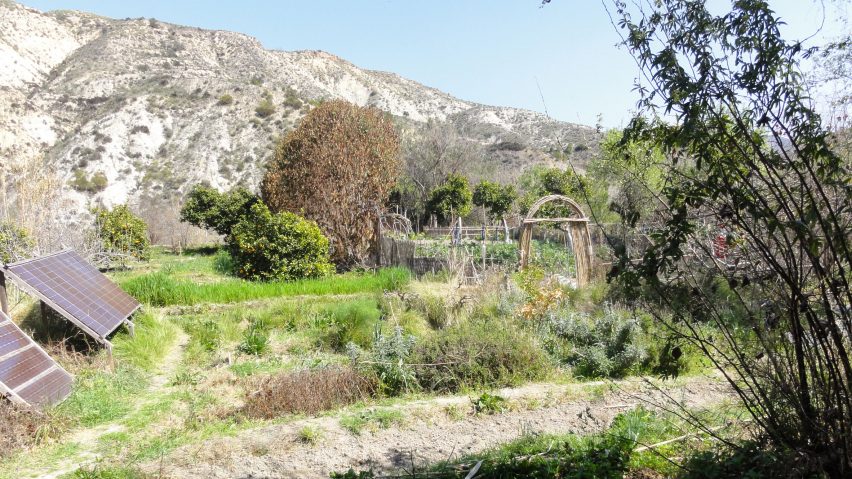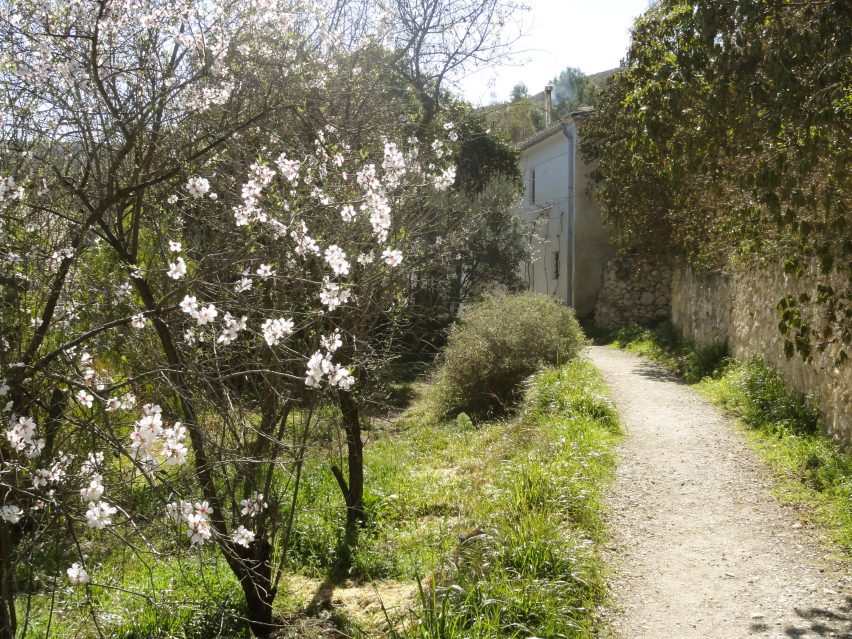
"At first I was enchanted by off-grid living. But the hardships quickly became apparent"
Marcus Field spent six years in an off-grid home. With architecture's contribution to carbon emissions in the spotlight and children striking against climate change, he asks if climate activists are prepared for the sacrifices needed to live sustainably.
There have been many low points during my long journey as an accidental climate-change warrior. I've lived through days without electricity when the weather has been too cloudy to generate solar power. I've woken up to find my vegetable garden decimated by wild boars. I've even headed out in the rain to use a compost toilet rather than waste clean water by flushing a loo.
But I think the nadir came in the winter of 2007 when I found myself waist deep in gooey mud trying to clear a collapsed ditch so that water would run to my house.
I say ditch, because the fact that it was a Moorish irrigation line to my off-grid home in Spain makes it sound too romantic. When you're freezing cold and dirty you don't care who built your water system, you're just dreaming of all the hot baths you've left behind.
I've been thinking a lot about these tough times since the recent reports of the children taking part in the Youth Strike 4 Climate events. These kids are very photogenic, with their painted faces and their heartwarming slogans, like "I speak for the trees" and "Burn incense not coal". But do they know what it's like to live like you mean it?
With only solar power for electricity, I had no energy-guzzling freezer, toaster or kettle
Whenever children visited me during my six years off-grid they always seemed distinctly unimpressed by the conditions I accepted in order to lower my carbon footprint. With only solar power for electricity, I had no energy-guzzling freezer, toaster or kettle. Warm water for showers from a solar coil on the roof was plentiful in summer, but a rare treat in winter. Curries made from potatoes and greens from the garden are delicious, but quickly lose their appeal when you eat them every day.
I agree with environmentalist George Monbiot when he says the youth-strike children shouldn't have to be "living in a barrel, with no clothes or possessions" for us to take their concerns seriously. But they do have many lessons to learn if they really want their generation to make an impact.
My own journey started in 2005, when I spotted an off-grid house for sale in the Spanish eco village of Los Molinos del Rio Aguas. I had spent 15 years in London working as a journalist, first on the Architects' Journal and later at Blueprint and the Independent on Sunday.
I thought I knew all about green buildings and energy-saving technology, and had always fancied giving the good life a go. However my only experience of low-impact living had been touring new offices and housing developments with architects keen to show off their theories about natural cooling and super-insulation. An AJ article on the pioneering 1993 home of architects Brenda and Robert Vale, complete with indoor compost toilet, had been an early inspiration, but reading about it was as far as I had got.
If we had understood the steepness of the learning curve we never would have done it at all
So when my boyfriend and I bought the house in Spain and moved there in early 2006, we were like energy junkies going cold turkey. Looking back it was a crazy thing to do, but if we had understood the steepness of the learning curve we never would have done it at all – which is why I call my crusade accidental.
Our small village house had been rebuilt from a ruin by a British environmentalist and his wife who were moving to Wales to expand their organic seed business. "I don't know how much you know about anarchist theory," Ben began when we first met him, by way of explanation for how he came to be living in what on the surface seemed like off-grid paradise.
The whole rural hamlet of 20 or so houses had been re-settled by eco-warriors from all over the world, with Sunseed, a British charity set up to demonstrate low-impact living to volunteers, the beating heart of the community. Our neighbours were Dutch and Germans, Americans and Spanish, as well as British people growing food and living in the simplest, greenest way possible.
At first I was enchanted by all the best bits of off-grid living. The solar-power system was small, but provided enough energy for computers, lights and a fridge on the lowest setting. To me, this free electricity from the sun seemed like a miracle. I loved the fact the house was built from materials found in the village: stone and gypsum mortar from the ground; poplar wood for beams; clay tiles for the roof and floors.
We soon learnt the novel squatting technique necessary to use the outdoor compost toilet
The irrigation line through the valley was our only source of water, brought up to a barrel on the roof by a 12-volt pump. It also watered the gardens, where I learnt how to grow crops of tomatoes, courgettes and potatoes. Waste water from the house went down a pipe, through a basic filter, and back onto the land. We quickly became vegetarian, partly to keep this recycled water as clean as possible.
Although the house had a WC, we soon learnt the novel squatting technique necessary to use the outdoor compost toilet. This delightful structure had collection chambers in its base and a roof of solar panels, all surrounded by a dense screen of grapevines. In theory the "humanure" we made could be dug out and used as compost for fruit trees, making the whole little building a multi-purpose power pack.

All of this was exciting to learn and satisfying to live with. But the hardships quickly became apparent too. We had no source of clean drinking water and had to fill up bottles every time we drove past a public spring (still common in Andalucia). Dull days quickly ran down our solar power supply and we had to limit our use of lights, computers and TV, occasionally abandoning these things all together. Winter storms led to the collapse of the irrigation line, meaning we were sometimes without water to wash.
There were also tensions in the community. When all your neighbours are idealists, it's extraordinary how quickly disagreements break out about the best way to live or solve problems. There are extremists in the green movement, just as there are in any community, and there were often people in the village who were so strict in their vegan, anti-oil, anti-capitalist, anti-children (due to concerns about the effects of population increase) position that their faces were fixed in a constant expression of disapproval.
Despite the downsides, I look back on my eco-adventure as a very happy time. And now I'm living back in Britain I often think about how the lessons I learnt could contribute to the UK Climate Change Act's commitment to cut our 1990-level of carbon emissions by 80 per cent by 2050. Certainly there's a mammoth task ahead.
The wealthier countries become, the cleaner they generally become, and more able to protect their natural assets
The Youth Strike 4 Climate movement has captured the public imagination with its demand for government action, and it's clear that national and international legislation can make the biggest leaps in environmental protection. Moves against diesel emissions, plastic bags and river pollution for example have had dramatic effects. And as Harvard professor Steven Pinker has pointed out in his recent book, Enlightenment Now, there is plenty to be positive about. The wealthier countries become, the cleaner they generally become, and more able to protect their natural assets.
However there is much more to do in the biggest fight of all, which is against greenhouse gas emissions. We must reduce these emissions by half if we are to keep the global temperature rise below two degrees Celsius this century, and thus curtail the increase in floods, droughts and other extreme weather conditions which are causing such destruction and heartache.
With 86 per cent of the world's energy still coming from fossil fuels, it's clear that increased development of alternative technologies like wind and solar power are a priority. Governments must take a lead role in this, and we can't assume that leftwing governments will be any better at it than rightwing ones. When jobs and profit come first, the environment often suffers. Heavy industry is still the biggest emitter of the world's greenhouse gasses at 29 per cent, and no government wants to close down car factories, quarries or steelworks, so the pressure must be on making them cleaner, whoever is in charge.
Architects also have an important role to play. Buildings are not far behind industry, emitting 19 per cent of the world's greenhouse gases. We are still way too blasé about the materials used in construction, the energy they take to make and transport, and the power buildings use to stay warm or cool.
My idea of a beautiful building has changed radically since I had my green epiphany, with innovative forms and smart tech less important to me than how much energy a building uses and whether it would decompose well when its life is over (not something you can imagine of The Shard for example). For me, a compost loo is now as forward looking as a gender-neutral one.
But as Steven Pinker says, the progress gained through legislation and technology "doesn't mean that we can sit back and relax". Everybody needs to play their part in this fight. And this is where the lessons I learnt in Spain are most useful to me. After my cold-turkey experience, it's now second nature to use only the lights I need at home, to heat water and rooms sparingly and to treat such things as a luxury.
I still get a huge amount of satisfaction from the planet-saving hacks I picked up when I became an accidental climate-change warrior
I recycle water at every opportunity, and applaud Sir James Bevan, chief executive of the Environment Agency, who said recently that he wants to see wasting water become "as socially unacceptable as blowing smoke in the face of a baby". I'm pleased with any food I manage to grow myself, and every time I walk or use public transport rather than my car, I think about the small amount of greenhouse gas that the atmosphere has been spared.
I eat a mostly vegetarian diet, with regular vegan days or weeks as a slow transition to the next step. These things all seem like common sense to me now, so I'm surprised when I meet other people who don't feel the same.
Veteran foreign correspondent John Simpson recently tweeted his support for making lessons on climate change compulsory in schools. "Since this is the most important problem our planet faces, shouldn't our children be taught about it?" he wrote. I agree, but it makes no sense if you don't teach them the small changes they can make to their lives to counteract it too.
I learnt on the job, and I still get a huge amount of satisfaction from the planet-saving hacks I picked up when I became an accidental climate-change warrior. I hope the next generation will soon learn to do the same.